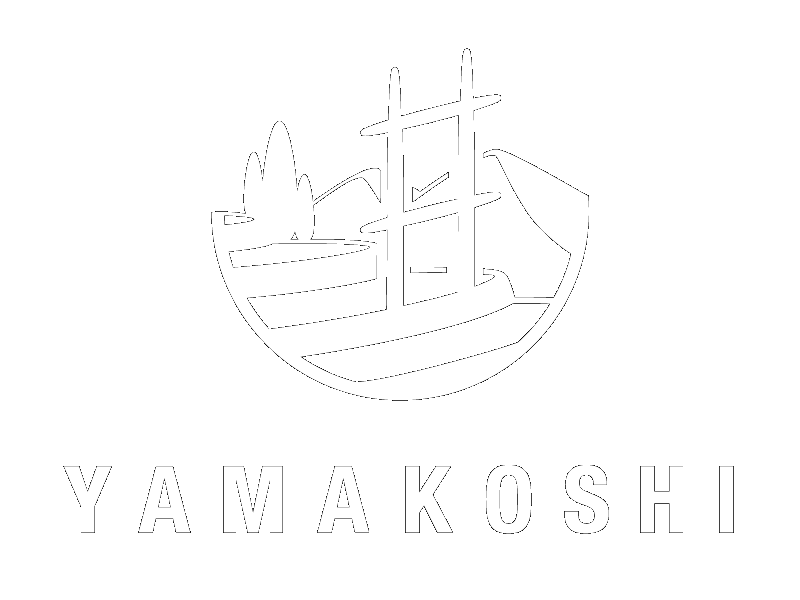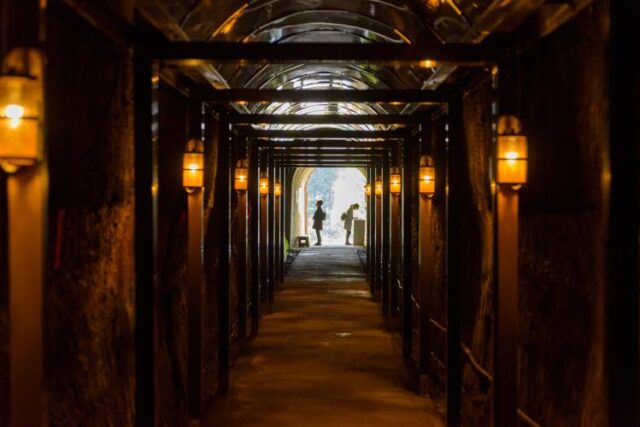
Surrounded by mountains, Yamakoshi endures some of the world’s heaviest snowfalls, in excess of 4 meters each season. The accumulated snow posed an obstacle to traffic in and out of the village up through the early Showa era (1926-1989). Crossing the mountain passes in winter was dangerous, and avalanches not infrequently took the lives of villagers.
As the pace of modernization picked up after the Meiji era (1868-1912), the need for road maintenance to overcome the limitations of the poor traffic conditions caused by heavy snowfall came to be recognized. This was due in part to the national development of Japan’s commercial economy and the growing need to secure exchange with other regions in support of village life. With the start of Showa-era road maintenance programs, the first attempts were made to dig tunnels through the mountains.
Let us now retrace the footsteps of our predecessors, who persevered through and overcame the difficulties of this harsh natural environment with their strong aspiration and indomitable spirit.
Why did our predecessors dig a tunnel by hand?
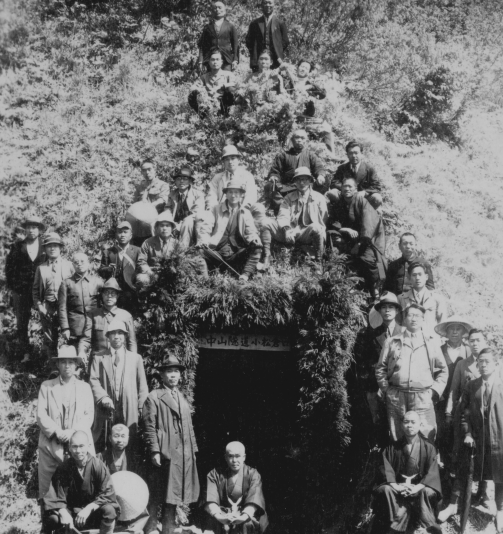
Until the 1930s, , the people of Komatsugura village, on the eastern edge of Yamakoshi, for centuries had to cross a mountain pass tothe neighboring village (now Uonuma City) just to get daily necessities, but also for medical treatment, meaning the sick had to be carried on stretchers over the forbidding route.
Even just carrying a heavy load over the pass is difficult. In winter, with snow accumulation of up to 4 meters, buried in snow up to the waist and caught in a blizzard, it is especially difficult. Villagers used to gather together to avoid danger when making the passage, but even so, there is a tragic history of people losing their lives in avalanches and other accidents.
To overcome this difficulty, the villagers decided to rise up, band together, and dig a tunnel– using only single-bladed pickaxes.
“The tunnel is approximately 900 meters long. If they dug 45 meters a year, they could open the tunnel in 20 years.”
This belief in risking their lives inspired the villagers, and the groundbreaking ceremony was held in November 1933, marking the “anniversary of the death of the mountain god.”
The Path through the Mountain Was Never Smooth
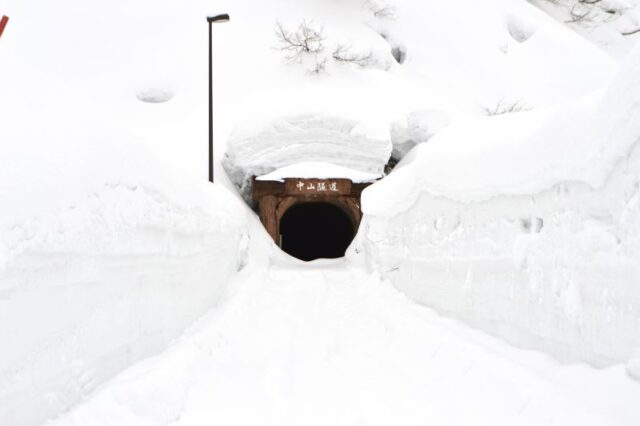
The village was supposed to stand together as one, but things got off to a rocky start.
Tunnel digging began with a confrontation between proponents and opponents.
The tunnel digging was done in the winter, during the agricultural off-season. However, since most men in those days spent the winter working at odd jobs other than farming, committing to the tunnel meant sacrificing this income, making their lives even more difficult. A complete lack of public assistance for the project compounded the problem, and the conflict with the opposition only deepened. With some participants dropping out, the project did not proceed as planned.
Furthermore, when the Sino-Japanese War broke out in 1937 and developed into WWII, the village’s young men, the mainstay of the labor force, went off to war, resulting in a shortage of manpower, fuel, and resources. As a result, work had to be suspended at the 324-meter mark, 10 years after drilling began.
Construction resumed after WWII ended, four years after the interruption.
In 1946, in the wake of WWII, the villagers of Komatsugura Village, despite lacking sufficient food and supplies, rose up once more to dig the tunnel. With a partial subsidy from Niigata Prefecture for construction costs, the villagers joined forces to dig the tunnel at a pace ten times faster than before the interruption. The work was passed on to the next generation, and finally, after 16 years, the Nakayama Tunnel, Japan’s longest hand-dug tunnel at 922 meters, was completed by the children of the workers who started it on May 1, 1949.
The tunnel would go on to provide much-needed support the people of Yamakoshi: some found spouses on the other side of the tunnel, while others found work; still others, having suddenly fallen ill, had their lives saved thanks to the tunnel.
Recognized as a Japanese “Civil Engineering Heritage” Site in 2006
Fifty years after the completion of the hand-dug Nakayama Tunnel, the “New Nakayama Tunnel” was completed in December 1998.
The “hand-dug” tunnel, which had completed its role, was scheduled to be closed and filled-in, but Niigata Prefecture and the Yamakoshi Village responded to the passionate calls of the residents of Komatsugura Village to preserve the Nakayama Tunnel. After Preservation work later began on the Nakayama Tunnel, and in 2006, it was recognized as a Japanese “Civil Engineering Heritage” Site.
We want to pass on to future generations the aspirations of our predecessors, who perservered through blood, sweat, and tears to accomplish their dream of a better life for future generations. . It is with this strong desire that the Nakayama Tunnel was left as a precious gift to future generations.
The people of Yamakoshi Village spoke of their hopes and struggles at the time.
The Nakayama Tunnel, the longest hand-dug tunnel in Japan, was dug by the villagers to overcome the inconvenience of poor winter roads. Yet it seems that at the outset, not all villagers were in favor of digging the tunnel. Let’s take a look at the thoughts of the villagers of the time, which have been passed down to the present day.
Episode 1: Why the split between tunnel advocates and opponents?
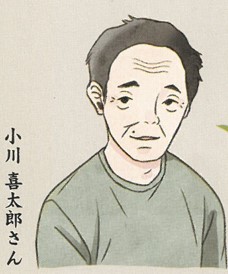
“When the idea of digging a tunnel came up, most of the villagers thought it was a pipe dream. It was obvious that if the villagers dug the tunnel as volunteers, they wouldn’t be able to work elsewhere in the winter, they would lose that income, and then their families would suffer.” Kitaro Ogawa, who still lives in Komatsugura village, said that his grandfather must have thought of the villagers’ situation and opposed the tunnel.
The village broke down into factions for and against the tunnel after the villagers held serious discussions about the village and its future.
Episode 2: After the war, the Komatsukura community came together to dig the tunnels by hand.
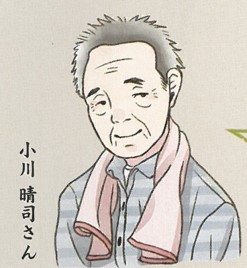
“The women carried six pick-axes with worn-down tips over the snowy Nakayama Pass to the blacksmith shop in the neighboring town. Children joined the adults in pushing trolly-carts to haul away the earth and sand they had dug up,” recalls Haruji Ogawa, who was a child at the time. He had a hard time getting the carts off the rails because the dirt he had dug out was so heavy.
“During the food shortages after the War, only the fathers of the diggers had white rice in their lunches. Every house was in the same situation, that is how much was expected of the diggers.” His narrative gives us a sense of the hardships faced by the villagers of the time and their faith in their ability to accomplish their tasks.
Admiring the stamina and skill of our predecessors
In Yamakoshi, where there is little flat land, villagers have for centuries employed the technique of digging “horizontal wells” to secure water. This technique is said to have been used to dig the longest hand-dug tunnel in Japan.
During the Heisei era (1989-2019), in a reenactment scene from the film ‘Horumaika’ the people of Yamakoshi attempted to dig once more with pickaxes, as their predecessors had. They were, however, unable to break the hard bedrock and had to use gunpowder. This curious episode of recent history shows the toughness of our ancestors, who perservered in an era without machines. It is said that “when you step into the Nakayama Tunnel, you can feel the spirit of our forefathers, and gain courage.”
The villagers’ 16 years of spirit, energy, and effort, spent facing this tunnel armed only with pickaxes, is connected to the present day and to the future through the film ‘Horumaika’.
